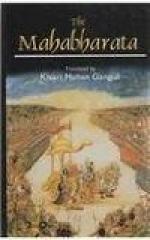107. Krishna is explained by the commentator thus. Krish is a word signifying Bhu or Existence. The letter n (the palatal one) signifies nivritti. Hence Krishna is anandatanmatra.
108. Kaparddin is thus explained by the commentator Kam Jalam pivati iti kapah. So called because of the incident noted in the text, for the matted locks of Mahadeva had sucked up the river Ganga when it first fell from heaven. Then Rit means sovereignty or lordship. Riddah is one that gives sovereignty. Combining the two, the compound Kaparddin is formed.
109. Nabhah means space which implies puissance. That Nabhah is the sthala or abode of Mahadeva. The Bengal texts which read Nabhastala are vicious.
110. The deities are said to move about during the day, while the Asuras and Rakshasas during the night. What is said, therefore, here is that thou art the deities and thou art their foes of the Daityas and others.
111. Sound, only when manifested, becomes perceptible. When unmanifest and lying in the womb of eternal space, it is believed to have an existence. Unmanifest Brahman is frequently represented as anahatah savdah or unstruck sound.
112. These four ways are as enumerated by commentator, Visva, Taijasa, Prajna, Sivadhyana.
113. It may also mean that thou art he called Buddha who preached against all sacrifices.
114. The commentator explains that Mahadeva’s defeat at the hands of Krishna in the city of Vana was due to Mahadeva’s kindness for Krishna, even as Krishna broke his own vow of never taking up arms in the battle of Kurukshetra, for honouring his worshipper Bhishma who had vowed that he would compel Krishna to take up arms.
115. The sense is this: when the universal destruction cones and all becomes a mighty expanse of water, there appears a banian tree under whose shade the immortal Rishi Markandeya sees a boy who is Mahavishnu.
116. It may also mean that thou art he at whose approach all the Daitya troops fled in all directions.
117. i.e., thou art Time itself. This is the implication.
118. By these three names what is indicated is that Mahadeva is a householder, it Sanyasin and a forest-recluse. House-holders bear a tuft of hair on their heads, Sanyasins have bald heads, while forest recluses or Vanaprasthis have matted locks.
119. The sense is that Brahman is felt by every one in the firmament of his own heart. Mahadeva, as identical with Brahman is displayed in the heart that is within the physical case. Hence, he may be said to take birth or appear in his effulgence within every one’s body.
120. Kalakatankatah is explained by the commentator as follows:—Kala is Yama. He is covered over with the illusion of the Supreme Deity. This all covering illusion, again, has the Supreme Deity for its cover. Thou art that Supreme Deity.
121. Vibhaga and Sarvaga, the commentator explains, are used for indicating that thou art the universe as Vyashti and Samashti.




